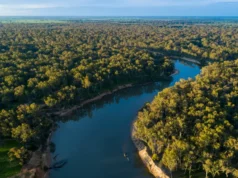
The Chedi is masked in mist as I trundle my luggage through the snow. I’ve just alighted the Glacier Express in Andermatt, a once unlikely outpost halfway along the famous rail journey from Zermatt to St. Moritz, through the heart of the Swiss Alps. The former garrison town guards the Gotthard Pass, and staff at the hotel wear a smart, military style uniform, the only nod to the upheaval that’s seen a five-star deluxe hotel rise where barracks once stood.
The lobby alone overwhelms the senses, with soaring oakwood panelling, glass-encased fireplaces, velvet lounges and cashmere blankets, Japanese paper lamps and log-sawn coffee tables. The obvious Asian influences are offset by unmistakably European scenes: a wolfhound resplendent in a sheepskin ski jacket, a young girl building a cushion cubby for her Shih Tzu while mum dozes on a daybed, draped in a fur coat. Black stone pillars suspend a slatted timber ceiling lurking somewhere in the stratosphere, and a 30-metres long chandelier floats above a black granite table that matches the chandelier for both size and intent. A piano player takes his seat and kicks the evening off. I scan the room and try to take it all in.
When the military withdrew from Andermatt in the 1990s the town look set to become a frigid backwater, before being unexpectedly resurrected in the mid 2000s by Egyptian construction tycoon Samih Sawiris, who sunk over a billion euros into building an all-new ski resort infrastructure, 42 apartments and six hotels. The Chedi – which opened in 2013 – is the piste de resistance of the relaunched town…
read the full story here


